Class 5 Science - Plant Life - CBSE Worksheets Solutions - 2
Q1: Fill in the Blanks.
(i) Plants produce their food through the process of ____________.
Ans: Photosynthesis
Photosynthesis is the process by which plants convert sunlight, water, and carbon dioxide into glucose and oxygen using chlorophyll present in their chloroplasts.
(ii) The green pigment responsible for photosynthesis is called ____________.
Ans: Chlorophyll
Chlorophyll is the green pigment found in chloroplasts of plant cells. It absorbs light energy from the sun, which is essential for photosynthesis to occur.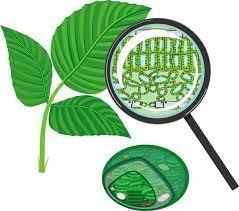
(iii) The process of pollination takes place with the help of ____________.
Ans: Pollinators
Pollinators, such as bees, butterflies, and birds, help in the transfer of pollen from the male reproductive part (anther) to the female reproductive part (stigma) of flowers, facilitating pollination.
(iv) The swollen base of the pistil is called ____________.
Ans: Ovary
The ovary is the swollen base of the pistil in a flower. It contains ovules that, when fertilized, develop into seeds.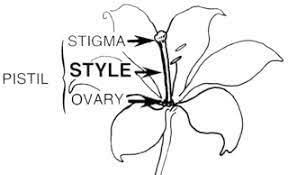
(v) The process of water movement through a plant is called ____________.
Ans: Transpiration
Transpiration is the process of water movement through a plant, from the roots to the leaves, where it evaporates into the atmosphere through tiny pores called stomata.
Q2: Match the Column.
Match the following plant parts with their respective functions:
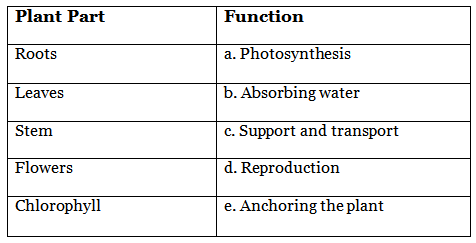 Ans:
Ans:
Roots - b. Absorbing water
Roots anchor the plant in the soil and absorb water and minerals from the soil for the plant's growth and nutrition.
Leaves - a. Photosynthesis
Leaves are the primary site of photosynthesis in plants, where chlorophyll absorbs sunlight to produce food for the plant.
Stem - c. Support and transport
The stem provides support to the plant and serves as a transportation system, carrying water and nutrients between the roots and leaves.
Flowers - d. Reproduction
Flowers are the reproductive structures of plants, where the male and female gametes combine to form seeds.
Chlorophyll - e. Anchoring the plant
Chlorophyll is not involved in anchoring the plant. It is responsible for capturing light energy during photosynthesis.
Q3: True or False.
(i) True/False: All plants need sunlight for photosynthesis.
Ans: False - While most plants need sunlight for photosynthesis, some can perform photosynthesis in low light conditions.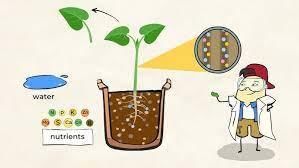
(ii) True/False: The process of pollination occurs after fertilization.
Ans: False - Pollination occurs before fertilization, where pollen from the anther reaches the stigma of the same or another flower.
(iii) True/False: Roots are responsible for absorbing carbon dioxide from the atmosphere.
Ans: False - Roots absorb water and minerals, but they do not absorb carbon dioxide. The leaves are responsible for absorbing carbon dioxide.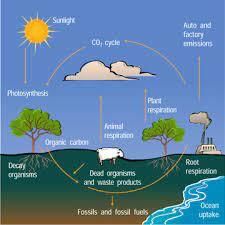
(iv) True/False: A plant cell has a rigid cell wall, while an animal cell does not.
Ans: True - Plant cells have a rigid cell wall that provides structural support, while animal cells do not have a cell wall.
(v) True/False: Insects play a significant role in the process of pollination.
Ans: True - Insects, such as bees and butterflies, play a significant role in the pollination process by transferring pollen from one flower to another.
Q4: Multiple Choice Questions.
(i) What is the primary function of a flower in a plant?
(a) To conduct photosynthesis
(b) To anchor the plant to the ground
(c) To absorb water and nutrients
(d) To facilitate reproduction
Ans: (d)
The primary function of a flower in a plant is to facilitate reproduction by producing seeds through the process of pollination and fertilization.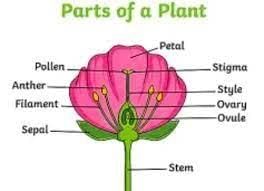
(ii) Which of the following plant parts is responsible for carrying water and nutrients between the roots and leaves?
(a) Flowers
(b) Stem
(c) Leaves
(d) Roots
Ans: (b)
The stem is responsible for carrying water and nutrients between the roots and leaves through specialized tissues called xylem and phloem.
(iii) Which part of the plant holds the pollen grains?
(a) Stigma
(b) Ovary
(c) Petal
(d) Anther
Ans: (d)
The anther is the part of the flower that holds the pollen grains, which contain the male gametes.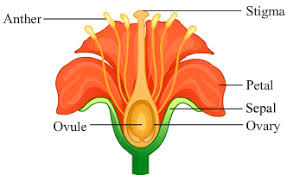
(iv) Photosynthesis mainly occurs in the cells of:
(a) Roots
(b) Stems
(c) Leaves
(d) Flowers
Ans: (c)
Photosynthesis mainly occurs in the leaves of the plant, where chlorophyll captures sunlight to produce food for the plant.
(v) What is the function of the stomata in leaves?
(a) Absorbing sunlight
(b) Transporting water
(c) Exchanging gases
(d) Providing support
Ans: (c)
Stomata are small pores on the surface of leaves that allow the exchange of gases, such as carbon dioxide and oxygen, between the plant and the atmosphere.
Q5: Arrange in Correct Order.
Arrange the following steps in the correct order for the process of pollination:
(a) Fertilization takes place.
(b) Pollen is transferred to the stigma.
(c) Insects carry pollen from one flower to another.
(d) Pollen tube reaches the ovary.
(e) Pollen grains are produced in the anther.
Ans: Correct Order is
(e) Pollen grains are produced in the anther.
(b) Pollen is transferred to the stigma.
(d) Pollen tube reaches the ovary.
(a) Fertilization takes place.
(c) Insects carry pollen from one flower to another.
The process of pollination starts with the production of pollen grains in the anther. These pollen grains are then transferred to the stigma of the flower. From the stigma, a pollen tube develops and reaches the ovary, where fertilization takes place, resulting in the formation of seeds. Some plants rely on insects to carry pollen from one flower to another, aiding in the pollination process.
Q6: Short Questions.
(i) Explain the process of photosynthesis in plants.
Ans: Photosynthesis is the process by which green plants and some other organisms use sunlight, carbon dioxide, and water to produce glucose (a form of sugar) and oxygen. This process takes place in the chloroplasts of plant cells. Chlorophyll, the green pigment present in chloroplasts, captures sunlight and converts it into chemical energy, which is used to synthesize glucose from carbon dioxide and water. The oxygen produced during photosynthesis is released into the atmosphere as a byproduct. This glucose is then used as a source of energy for the plant's growth and various metabolic processes.
(ii) Describe the various ways by which seeds can be dispersed.
Ans: Seed dispersal is the process by which seeds are spread from the parent plant to other locations, allowing new plants to grow in different areas. This process is crucial for plant reproduction and genetic diversity.
Various methods of seed dispersal include:
- Wind dispersal: seeds with wings or feathery structures.
- Water dispersal: buoyant seeds that can float.
- Animal dispersal: seeds that have hooks or are found in fruits eaten by animals.
- Explosive dispersal: seeds that burst open to scatter seeds.
Each method increases the likelihood of seeds reaching suitable environments for germination and growth, thus reducing competition with the parent plant.
(iii) Differentiate between taproots and fibrous roots.
Ans: Taproots and fibrous roots are two types of root systems found in plants.
- Taproots: Taproots have a main root that grows vertically deep into the soil. From the main root, smaller lateral roots branch out horizontally. Taproots are typically found in dicotyledonous plants, such as carrots and radishes. They provide strong anchorage to the plant and store nutrients.
- Fibrous roots: Fibrous roots form a dense network of thin, branching roots that spread out horizontally close to the soil surface. They are common in monocotyledonous plants, such as grasses. Fibrous roots help in absorbing water and nutrients effectively from the upper layers of the soil.
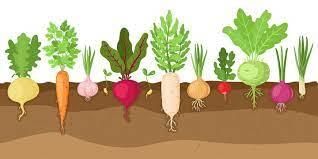
(iv) How does a plant respond to the stimulus of light? Give an example.
Ans: Plants respond to the stimulus of light through phototropism. Phototropism is the movement or growth of a plant in response to light direction. When a plant receives more light from one direction, it tends to bend or grow towards the light source. For example, a plant placed near a window will exhibit phototropism by bending its stems and leaves towards the window to maximize light absorption for photosynthesis.
(v) What is germination? Describe the conditions necessary for seed germination.
Ans: Germination is the process by which a seed develops into a new plant under favourable conditions. For successful germination, seeds require three main conditions:
- Water: Essential for the seed to swell and break through its outer shell.
- Suitable temperature: Optimal temperatures vary by species, but most seeds germinate best in warm environments.
- Oxygen: Necessary for respiration, allowing the seed to access energy for growth.
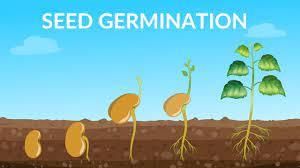
|
42 videos|343 docs|45 tests
|
FAQs on Class 5 Science - Plant Life - CBSE Worksheets Solutions - 2
| 1. What are the main types of plant life? |  |
| 2. How do plants reproduce? |  |
| 3. What is photosynthesis and why is it important for plant life? |  |
| 4. How do environmental factors affect plant growth? |  |
| 5. What are the benefits of plants to the ecosystem and humans? |  |





















